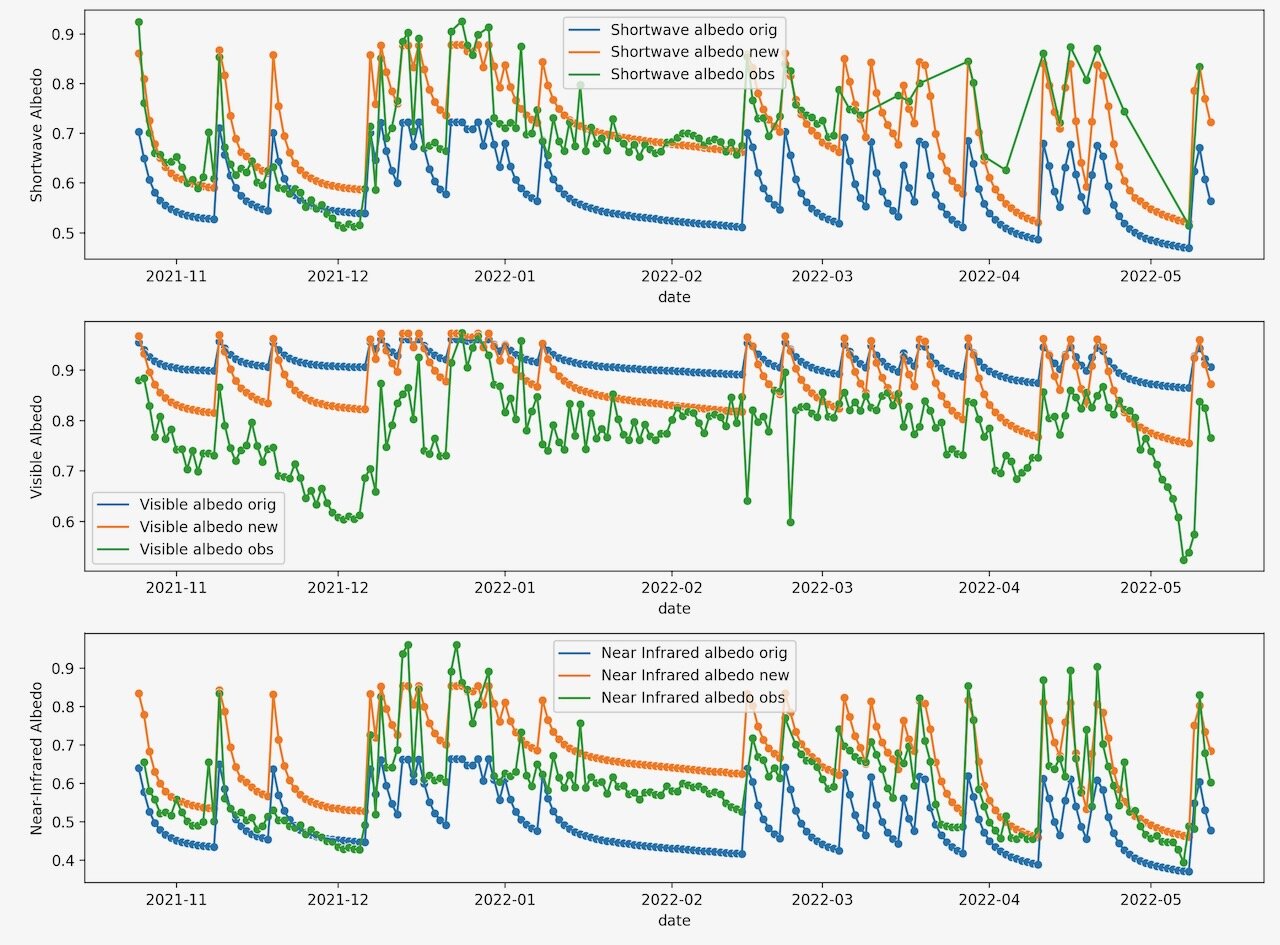Advancing Albedo Modeling Through Snowpack-Aware Grain Evolution
Advancing Albedo Modeling Through Snowpack-Aware Grain Evolution
At M3 Works, we’re always refining our snow modeling systems to better reflect the physical processes at play in real-world snowpacks. Snowpack albedo, or the reflectivity of snow, governs the rate of spring snowmelt and plays a key role in snowpack modeling and forecasting. Our latest improvement introduces a more physically realistic albedo calculation that incorporates snowpack temperature and dynamically adjusts grain growth in melting conditions. This advancement leads to a significant leap in both temporal and spatial accuracy.
The enhanced albedo model adds a melting snow grain growth factor, increasing the rate of optical grain growth specifically during melt freeze cycles. While previous models assumed a one-size-fits-all grain evolution rate, our updated approach uses measured snow temperature as a feedback into the albedo calculation. To our knowledge, this is the first operational model where snowpack state variables actively shape albedo evolution in real time. The feedback loop better captures how melting snow grains evolve faster than dry, cold snow, especially during sustained melt periods.
This new approach doesn’t just make theoretical sense, it shows clear improvements in real-world validation. In the first validation case, we compared the modeled and measured albedos at the CUES station in Mammoth, CA [1] for Water Year 2022, a year marked by extended dry spells and substantial mid-season grain evolution. The time series reveals dramatic improvements in mid-season and melt-season albedo estimates. Unlike the older model, which consistently underrepresented grain growth in the visible wavelengths and overrepresented grain size in IR albedo, the updated version tracks both the timing and magnitude of albedo decline with much greater fidelity.
Spatial performance also saw substantial gains. Our second validation plot compares modeled albedo to a May 2023 Airborne Snow Observatory, Inc. (ASO) retrieval over California’s Merced Basin. The new model shows lower mean bias and markedly better spatial heterogeneity, better reflecting real-world snow surface variability. The updated grain growth formulation avoids the overly smooth patterns of previous versions, especially across high-exposure or rapidly melting zones.
A third evaluation uses a basin-wide, time-averaged comparison to Rittger et al.’s MODIS-derived albedo dataset [2]. Again, the improved model tracks the seasonal albedo decay with significantly higher accuracy. Specifically, we see reduced error and improving agreement at both early melt and peak melt phases.
These updates are more than academic improvements. Albedo is a dominant control on spring melt timing and volume. By more accurately capturing how melting snow evolves optically, our new model enhances runoff timing predictions and improves the reliability of downstream water availability estimates.
M3 Works first used this method operationally in over 30 basins during water year 2025, creating more accurate snowpack data across the Western US.
Citations:
- The CRREL/UCSB Energy Site: https://snow.ucsb.edu, last access: 2025/05/28, doi: 10.21424/R4159Q
- Rittger, K., Lenard, S. J., Palomaki, R. T., Brodzik, M. J., Stillinger, T., Bair, E. H., Dozier, J. & Painter, T. H. (2024). Historical MODIS/Terra L3 Global Daily 500m SIN Grid Snow Cover, Snow Albedo, and Snow Physical Properties. (STC_MODSCGDRF_HIST, Version 1). [Data Set]. Boulder, Colorado USA. National Snow and Ice Data Center. https://doi.org/10.7265/f6j3-f387.
Micah Sandusky is a software developer, mechanical engineer, and scientific modeler. He started out using computational fluid dynamics to estimate wind power in mountainous terrain. He later launched into a snow hydrology career when he joined the USDA Agricultural Research Service to serve as the primary developer for the Automated Water Supply Model (AWSM), a framework now used by M3. Prior to cofounding M3 Works, Micah spent time as a developer in the commercial software industry where he cultivated his skills with data pipelines in the Cloud. At M3 Works, Micah coordinates our cloud infrastructure while developing new strategies for monitoring/maintaining our real time efforts to estimate snowpacks all across the Western US.
- M.S. Mechanical Engineering
- 10 years scientific modeling
- 10 years development experience
- 4+ years of Cloud experience

Solutions
Company
Resources
© 2024 M3Works. All rights reserved.
